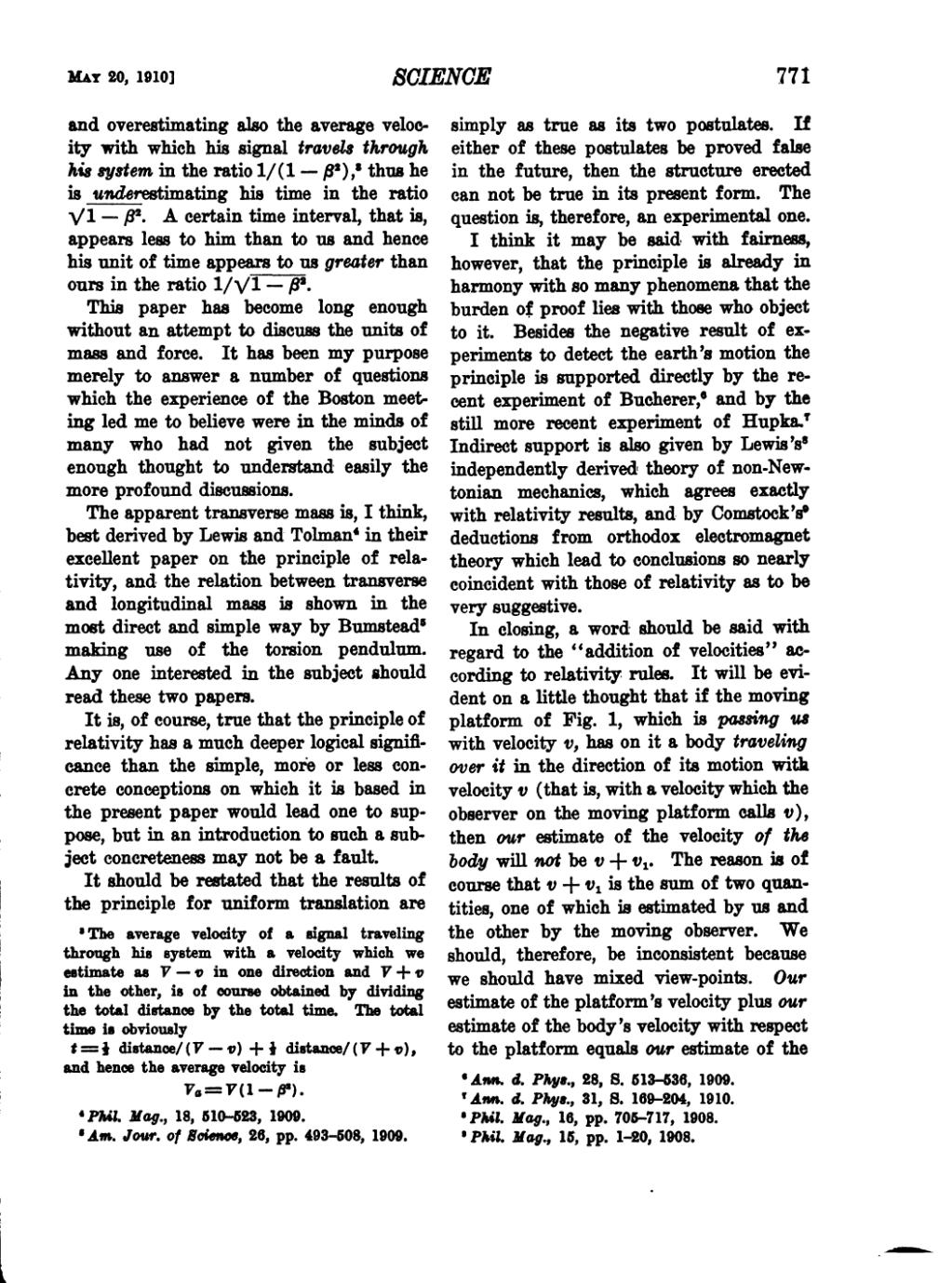and overestimating also the average velocity with which his signal travels through his system in the ratio 1/√(1—β²),[1] thus he is underestimating his time in the ratio √(1—β²). A certain time interval, that is, appears less to him than to us and hence his unit of time appears to us greater than ours in the ratio 1/√(1—β²).
This paper has become long enough without an attempt to discuss the units of mass and force. It has been my purpose merely to answer a number of questions which the experience of the Boston meeting led me to believe were in the minds of many who had not given the subject enough thought to understand easily the more profound discussions.
The apparent transverse mass is, I think, best derived by Lewis and Tolman[2] in their excellent paper on the principle of relativity, and the relation between transverse and longitudinal mass is shown in the most direct and simple way by Bumstead[3] making use of the torsion pendulum. Any one interested in the subject should read these two papers.
It is, of course, true that the principle of relativity has a much deeper logical significance than the simple, more or less concrete conceptions on which it is based in the present paper would lead one to suppose, but in an introduction to such a subject concreteness may not be a fault.
It should be restated that the results of the principle for uniform translation are simply as true as its two postulates. If either of these postulates be proved false in the future, then the structure erected can not be true in its present form. The question is, therefore, an experimental one.
I think it may be said with fairness, however, that the principle is already in harmony with so many phenomena that the burden of proof lies with those who object to it. Besides the negative result of experiments to detect the earth's motion the principle is supported directly by the recent experiment of Bucherer,[4] and by the still more recent experiment of Hupka,[5] Indirect support is also given by Lewis's[6] independently derived theory of non-Newtonian mechanics, which agrees exactly with relativity results, and by Comstock's[7] deductions from orthodox electromagnet theory which lead to conclusions so nearly coincident with those of relativity as to be very suggestive.
In closing, a word should be said with regard to the "addition of velocities" according to relativity rules. It will be evident on a little thought that if the moving platform of Fig. 1, which is passing us with velocity v, has on it a body traveling over it in the direction of its motion with velocity v (that is, with a velocity which the observer on the moving platform calls v), then our estimate of the velocity of the body will not be v+v1. The reason is of course that v+v1 is the sum of two quantities, one of which is estimated by us and the other by the moving observer. We should, therefore, be inconsistent because we should have mixed view-points. Our estimate of the platform's velocity plus our estimate of the body's velocity with respect to the platform equals our estimate of the
- ↑ The average velocity of a signal traveling through his system with a velocity which we estimate as V—v in one direction and V+v in the other, is of course obtained by dividing the total distance by the total time. The total time is obviously t=½ distance/(V—v) + ½ distance/(V+v), and hence the average velocity is Va=V(1-β²).
- ↑ Phil. Mag., 18, 510-523, 1909.
- ↑ Am. Jour, of Science, 26, pp. 493-508, 1909.
- ↑ Ann. d. Phys., 28, S. 513-536, 1909.
- ↑ Ann. d. Phys., 31, B. 169-204, 1910.
- ↑ Phil. Mag., 16, pp. 705-717, 1908.
- ↑ Phil. Mag., 15, pp. 1-20, 1908.
